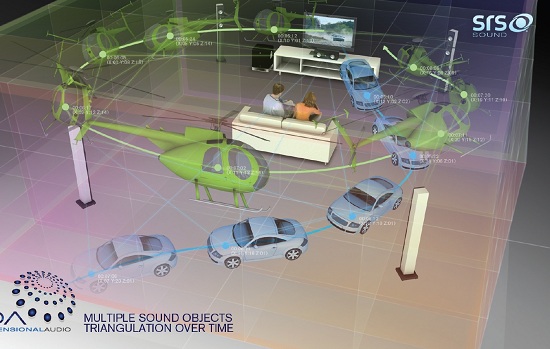Bringing the ‘Voice of God’ to TV Audio
LOS ANGELES—The addition of speaker channels above the familiar 5.1 or 7.1 surround sound array can recreate an exceptionally lifelike ambient soundfield, and enables much more accurate localization of aerial objects, such as helicopters. Although surround sound has taken an evolutionary step over the past decade by adding a “height” component to the traditional horizontal configuration of loudspeakers, more recent advances in 3D video have led to the emergence of a variety of 3D sound schemes.

SRS Labs introduced its Multi-Dimensional Audio platform in January. With MDA, sound objects move through full 3D time and space without dependence on limited and conventional available channels using any type of speaker configuration. But for some, 3D sound is a misnomer: “I think ‘immersive’ is a good way of looking at it,” said Jeff Levison, vice president of cinema and entertainment systems with Iosono, a provider of 3D audio technology, at the recent AES Convention in San Francisco.
As Wieslaw Woszczyk, James McGill professor, director, recording studios, at Montreal’s McGill University, noted during one session, height is not a new thing. “Probably the best surround sound with height experience was with the cavemen; imagine spaces that were naturally shaped that provided sound from above and below,” he said, also noting that the dome of the Hagia Sofia in Istanbul, completed in 537 CE, “has natural amplification of sound coming from above.”
A MORE ‘IMMERSIVE EXPERIENCE’
Stereo, 5.1 and 7.1 configurations are all capable of producing encompassing sound, but even before the advent of practical 3D picture delivery, surround sound system developers were exploring ways of adding height information for a more immersive experience. One early example, IMAX, offered the opportunity for a center upper “voice of God” channel. In 1999, Dolby Laboratories pioneered height reproduction with Dolby Digital Surround EX, which for the first time allowed sounds to be panned overhead through the addition of a center rear channel.
Audio expert Tomlinson Holman (now with Apple), included front left and right height channels in his 10.2 scheme, which was introduced in 2001 and was made commercially available via Audyssey DSX (Dynamic Surround Expansion) in 2009. Dolby Labs, too, introduced its Prologic IIz codec a few years ago, adding similar height channels to standard 5.1 and 7.1 configurations. DTS launched its own 11.1 format, DTS Neo:X, which includes height channels, in early 2011.
Channel counts of the aforementioned configurations are currently somewhat limited by what can be squeezed into the respective discrete or matrix-ed codec technologies, but new object-based formats have greatly expanded the possibilities. In these schemes, sounds are mapped into three-dimensional space, and each audio object, whether it appears for a brief moment or continues for the full length of the soundtrack, is accompanied by metadata describing its spatial position. Object-based methods allow sounds to move through, or be positioned anywhere in space, including on the height axis; but since they are not channel-based, they will typically also reproduce on systems with fewer loudspeakers, such as traditional 5.1 and 7.1 layouts.
Iosono, for example, a German company that was spun off from Fraunhofer DMT (Digital Media Technologies), supports as many as 380 separate speakers, but can still translate effectively with far fewer. “Fifty to 60 speakers give extremely reasonable results in cinema. With a triangulated array you can move things around on the ceiling and have it sound the same from anywhere in the room,” said Levison.
The professional video industry's #1 source for news, trends and product and tech information. Sign up below.
The new Dolby Atmos format allows for up to 128 channels and 64 discrete speaker feeds. The Multi-Dimensional Audio platform unveiled by SRS Labs in January 2012 is an open source scheme—essentially PCM plus metadata, rather than a codec—that can be mapped to any speaker layout, current or future, according to the company.
Very recently introduced, Spheraudio Upmix Powered by Illusonic, a collaboration between Digital Media Solutions of France and Illusonic, a European spatial audio company, supports layouts from 7.1 to 65.2. Also vying for a foothold in the burgeoning immersive sound market is Auro-3D from Auro Technologies, a spinoff from Belgium’s Galaxy Studios that is backed by Barco, and which supports layouts up to 13.1.
AUDIO FOR SUPER HI-VISION
These immersive sound systems have thus far been used almost exclusively for cinema or special event presentations, and in many cases are also aimed at the lucrative automotive market. It remains to be seen whether any of them will be integrated into global broadcast standards.

Kimio Hamasaki Meanwhile, NHK, Japan’s national public broadcaster, has been developing a system capable of transmission into the home. First made public in 2005, the immersive sound component of Super Hi- Vision (SHV), which also includes the 8K UHDTV picture format, 22.2 is also known as “Hamasaki 22.2,” after Kimio Hamasaki, senior research engineer, NHK Science & Technology Research Laboratories.
“We don’t want to put 24 speakers in your room,” said Hamasaki at AES last month. Hamasaki vocalized one of the main challenges to wider acceptance of any surround format in the home—how and where to install all of the required loudspeakers, especially in the average Japanese home, with its limited real estate. There is a matrix within the 22.2 format for downmixing to smaller speaker layouts, but NHK is also developing a speaker array frame, according to Hamasaki. The frame, which fits around the screen, houses almost 100 tiny speakers, and also very effectively reproduces 5.1, he noted.
As Hamasaki explained, the optimum positioning of the speakers for the 22.2 layout was arrived at following extensive research. The configuration comprises nine upper speakers, including one center overhead channel, 10 ear-level speakers, plus three channels across the foot of the screen, to reproduce such effects as footsteps, car tires, or other objects falling on the ground.
NHK has conducted numerous experimental broadcasts with SHV, but its largest to date was during the London 2012 Olympics. The broadcaster has been collaborating with BBC Research and Development for four years, and shipped almost every piece of its SHV-related equipment to London for the Games.
Such cutting edge technology has required the development of an entirely new toolset for production and post production capable of handling 3D panning, mixing and processing. For instance, Woszczyk, McGill University’s Brett Leonard and others have collaborated on Space Builder, an impulse response-based 3D ambience processor. NHK shipped its custom-built, 600-channel Fairlight Constellation mixing console platform to London. The broadcaster has also developed point source, a 24-channel microphone, for instance. It is currently 60 cm (nearly two feet) in diameter, said Hamasaki, but NHK is working on a version that is only 45 cm (roughly 18 inches).
Steve Harvey began writing for Pro Sound News and Surround Professional in 2000 and is currently senior content producer for Mix and a contributor to TV Tech. He has worked in the pro audio industry—as a touring musician, in live production, installed sound, and equipment sales and marketing—since November 1980.
